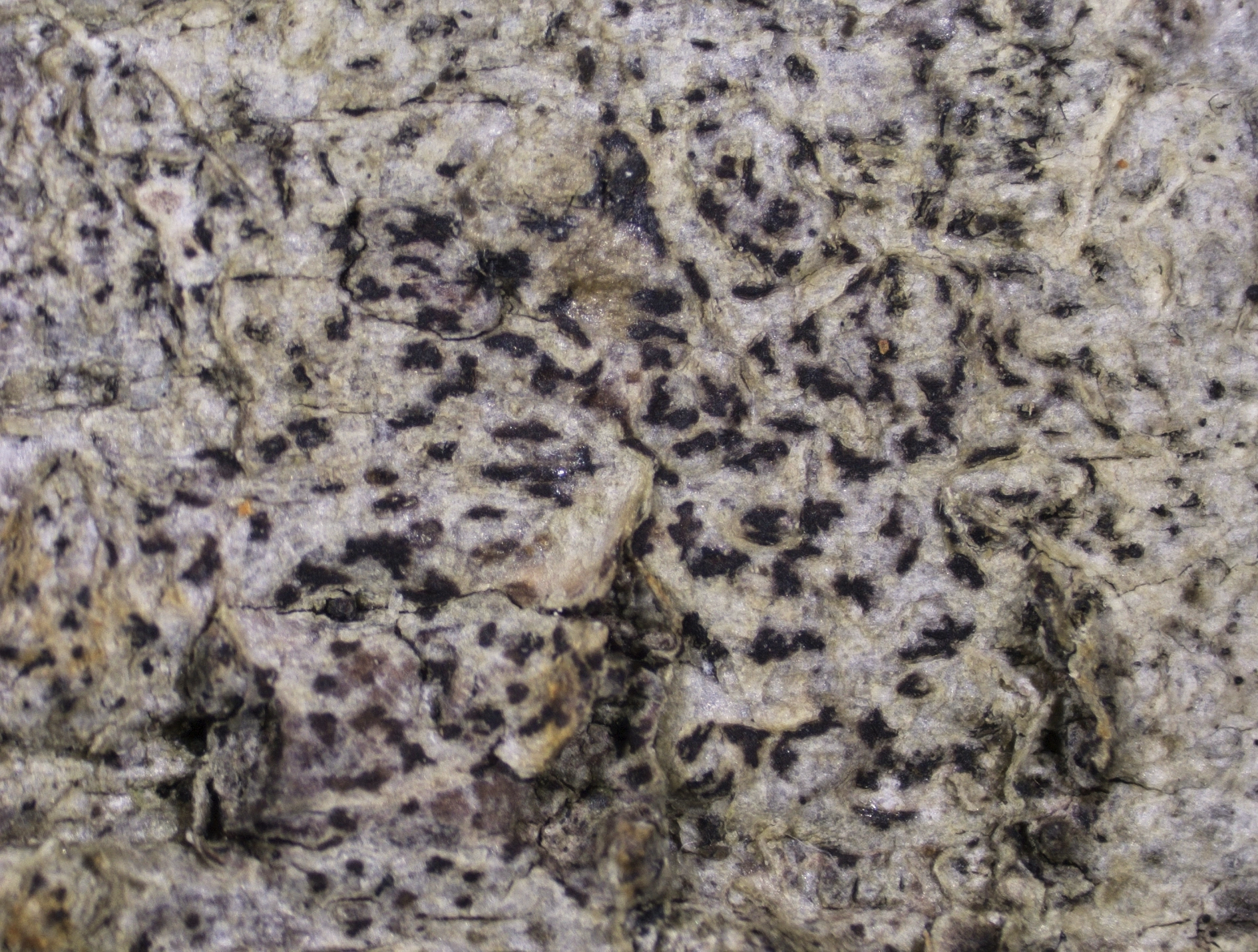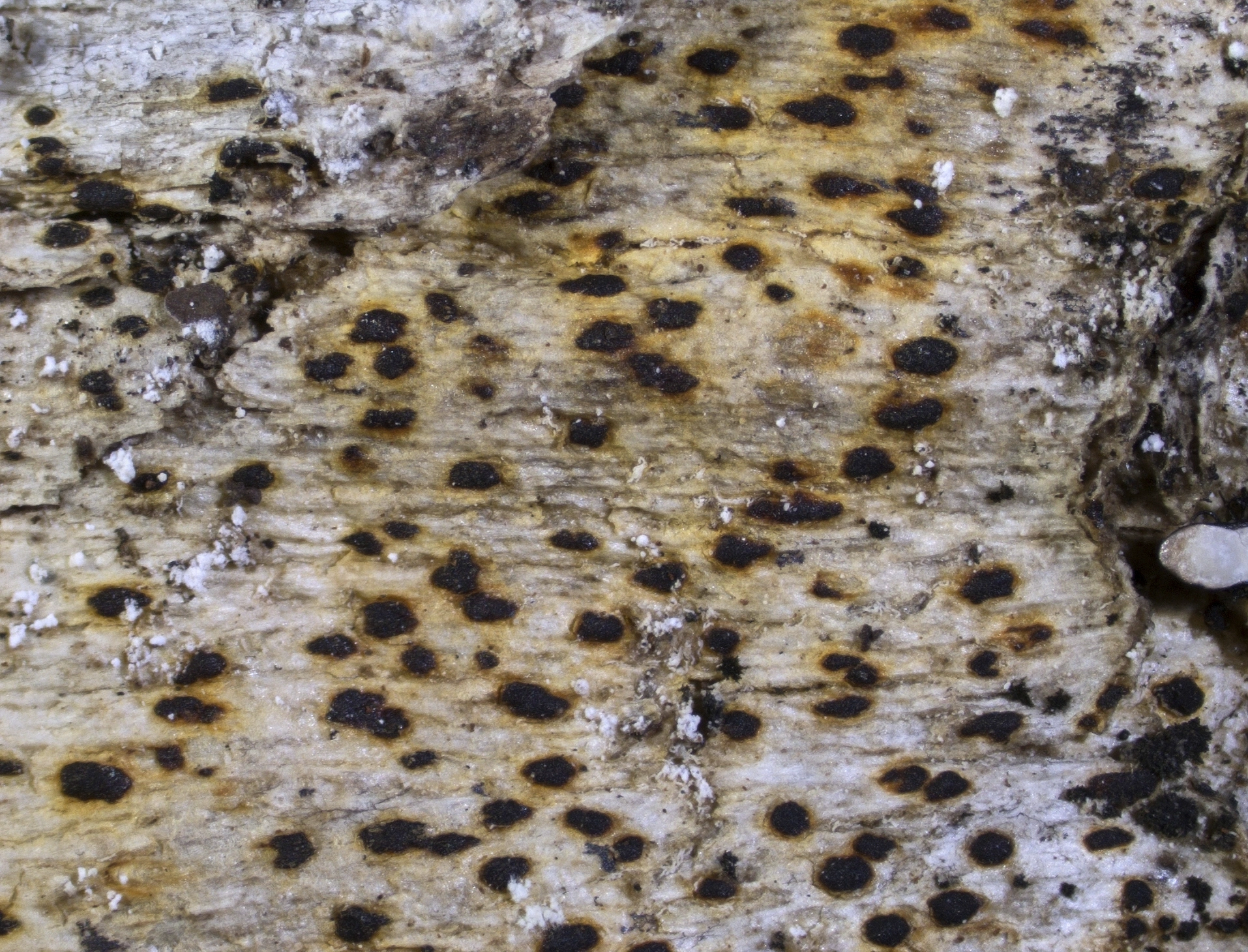Diarthonis spadicea
Diarthonis spadicea is a species of shady and humid forest communities in southern and central Norway. It often grows near the bases of deciduous and coniferous trees. Diarthonis spadicea is characterized by large brownish black, maculate apothecia on an olive-grey thallus with trentepohlioid photobiont. The colorless spores are 1-septate.
- Innhold
- Description
- Ecology
- Distribution in Norway and the Nordic countries
- Global distribution
- Similar species
Diarthonis spadicea collected from Tilia cordata at Strandåsen vestre in Porsgrunn (O-L-222400).
Description
Thallus
The thin but extensive thallus is olive-grey to grey, and immersed in the tree bark to superficial. The margin is not determinate. The photobiont is a species of the family Trentepohliaceae.
Fruitbodies
The apothecia are maculate, either level with the thallus or slightly raised, brownish black with often a reddish hue, and without pruina. They are irregularly rounded, 0.2–1.5 mm in size and 60–90 μm tall. The disc is flat to slightly convex and often slightly glossy.
The epithecium is indistinct.
The hymenium is pale orange-brown and 25–40 μm tall.
The hypothecium is pale orange-brown and up to 50 μm tall.
The paraphysoids are 1–1.5 μm wide and not enlarged in the tips.
The asci are clavate to obovoid, with stipe, 18–30 × 9–14 µm, and 8-spored.
The spores are colorless, obovoid to slipper-shaped, often slightly constricted at the septum, 7–11 × 3–4 μm in size, and divided by 1 transverse septum.
Anamorph
Pycnidia are reddish brown, immersed in the thallus, and 80–100 µm in size. The wall is reddish- to orange-brown. The rod-shaped conidia are 3–5 × ca 1 μm in size, and straight or slightly bent.
Chemistry
The thallus does not react with C, K, KC, Pd, or UV (C–, K–, KC–, Pd–, UV–). Lichen secondary compounds have not been detected by TLC.
The hymenium reacts I+ red and KI+ blue. A KI+ blue ring structure has been observed in the asci.
The reddish- to orange-brown pigment in the epithecium and in the wall of the pycnidia changes to purplish without dissolving in K solution.
Diarthonis spadicea collected from an old Quercus sp. at Gullkronene in Tønsberg (O-L-226434).
Ecology
Diarthonis spadicea typically grows towards the bases of deciduous and coniferous trees in the shady interior of humid forest communities. The species prefers flanks of the tree trunk exposed to rain and often occurs on slightly decayed, soft bark soaked with water by rain. Common host trees in Norway include alder (Alnus spp.), European ash (Fraxinus excelsior), common hazel (Corylus avellana), oak (Quercus spp.), rowan (Sorbus aucuparia), small-leaved lime (Tilia cordata), goat willow (Salix caprea) and wych elm (Ulmus glabra).
Diarthonis spadicea is widely distributed in temperate climates of the northern Hemisphere. In Europe, is largely absent from northern Fennoscandia as well as any true Mediterranean climate.
Distribution in Norway and the Nordic countries
Diarthonis spadicea is mainly a southern species in Norway. Its known distribution extends from Viken to Vestland, with few findings in Trøndelag. In the Nordic countries, it is also known from Denmark, Finland and Sweden.
Global distribution
Outside the Nordic Countries, D. spadicea is widely distributed in temperate Europe, North America and Asia.
Similar species
Well developed, Diarthonis spadicea is a characteristic species that is easily identified.
Morphs of Arthonia didyma with K+ purple pigments have smaller and more fleck-like apothecia 0.1–0.5 mm in size that are often elongated or even indistinctly branched. The spores are 12–18 × 5–8 µm in size and brown pigmented with warty ornamentation when old.
The apothecia of Arthonia vinosa are distinctly convex when well-developed with often steep flanks. The spores are 10–17 × 4–7 µm in size and brown pigmented with warty ornamentation when old. The K+ pigments dissolve with purple solution.
Literature
Cannon P, Ertz D, Frisch A, Aptroot A, Chambers S, Coppins BJ, Sanderson N, Simkin J and Wolseley P (2020). Arthoniales: Arthoniaceae. Revisions of British and Irish Lichens 1: 1–48.
Sundin R (1999). Phylogenetic and taxonomic studies within Arthonia Ach. (Ascomycetes, Arthoniales). Botaniska institutionen, Stockholms universitet, Stockholm.
Wirth V, Hauck M and Schultz M (2013). Die Flechten Deutschlands, vol. 1+2. Ulmer, Stuttgart. 1244s.



